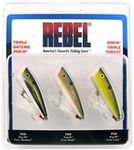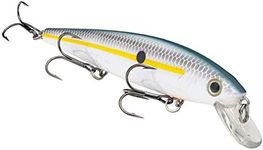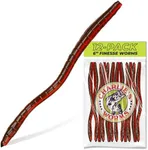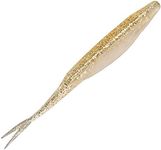Buying Guide for the Best Bass Lures
Choosing the right bass lure can significantly improve your fishing experience and success rate. Bass lures come in various shapes, sizes, and colors, each designed to attract bass in different conditions and environments. Understanding the key specifications of bass lures will help you make an informed decision and select the best lure for your fishing needs.Type of LureThe type of lure is crucial because different lures are designed to mimic various prey and work in specific water conditions. Common types include crankbaits, spinnerbaits, jigs, soft plastics, and topwater lures. Crankbaits are great for covering a lot of water quickly, spinnerbaits are effective in murky water, jigs are versatile and can be used in various conditions, soft plastics are excellent for a natural presentation, and topwater lures are exciting for surface strikes. Choose a type based on the water conditions and the behavior of the bass in your fishing area.
Lure SizeLure size matters because it affects the lure's visibility and the size of the bass it attracts. Smaller lures (1-3 inches) are ideal for catching smaller bass or when the fish are not very aggressive. Medium-sized lures (3-5 inches) are versatile and can attract a range of bass sizes. Larger lures (5 inches and above) are used to target bigger bass and are more visible in deeper or murkier waters. Consider the size of the bass you are targeting and the water clarity when selecting the lure size.
Lure ColorLure color is important because it can influence the bass's ability to see and be attracted to the lure. Natural colors like green, brown, and silver are effective in clear water and mimic the appearance of real prey. Bright colors like chartreuse, white, and neon are better for murky or stained water as they stand out more. Dark colors like black and blue work well in low-light conditions or at night. Match the lure color to the water conditions and the natural prey in the area to increase your chances of success.
Lure ActionLure action refers to the movement of the lure in the water, which can attract bass by mimicking the behavior of prey. Some lures have a wobbling or vibrating action, while others may have a more subtle or erratic movement. Fast-moving lures with a lot of action are great for active bass, while slower, more subtle lures are better for lethargic or pressured fish. Consider the activity level of the bass and the water conditions when choosing a lure with the appropriate action.
Depth RangeThe depth range of a lure determines how deep it will go in the water. Shallow-running lures (0-5 feet) are ideal for fishing in shallow waters or near the surface. Medium-depth lures (5-15 feet) are suitable for fishing in mid-depth waters. Deep-diving lures (15 feet and deeper) are used for reaching bass that are holding in deeper water. Choose a lure with a depth range that matches the depth at which the bass are located in your fishing area.






















